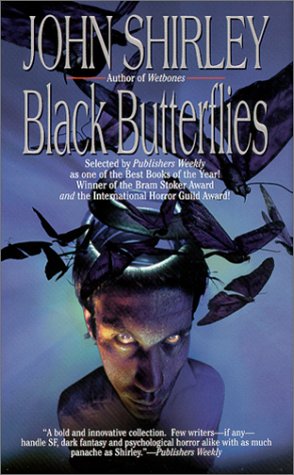 By JOHN SHIRLEY (Leisure; 1998/2001)
By JOHN SHIRLEY (Leisure; 1998/2001)
Easily the strongest collection of John Shirley stories since 1989’s HEATSEEKER. That long out of print Scream/Press publication was my first introduction to the work of Mr. Shirley, who for those who don’t know is one of the wildest, most unpredictable talents on the literary horror/sci fi scene. His early novels TRANSMANIACON and CITY COME A WALKIN’ were prototypes of the cyberpunk movement, while his intense 1982 horror-fest CELLARS directly foreshadowed the splatterpunks. But the author’s short stories are something else entirely, showcasing this one-of-a-kind talent at his most varied and confrontational.
Restraint is something you won’t find much of in a John Shirley story, and that’s particularly true here. Indeed, the contents of BLACK BUTTERFLIES are so strong I’m surprised the book, initially published as a limited edition trade paperback, made it to mass market form (courtesy of Leisure’s now-defunct paperback horror line). Included are generous dollops of gore, perverted sex, cannibalism and drug (ab)use, all of it related through tough, streetwise prose.
BLACK BUTTERFLIES’s sixteen stories are divided into two parts. Eight of them are set in “This World” and inspired by Shirley’s experiences as a punk rocker and drug addict in the 1970s (further detailed in his 1996 collection THE EXPLODED HEART), and the other eight take place in “That World.” The latter portion, prefaced by the Philip K. Dick quote “If you think this universe is bad, you should see some of the others,” is concerned with druggy, hallucinatory horror.
Obviously I preferred “That World,” although there are some strong offerings in “This World,” most notably “You Hear What Buddy and Ray Did?” and “What Would you Do for Love?,” two of the most squalid fictional looks at Hell on Earth I’ve ever encountered. Also worthwhile is the International Horror Guild award winning “Cram,” which provides an up-close view of a particularly hideous subway accident, and the unspeakable carnage that results.
“That World” includes irresistible exercises in surrealism like “Delia and the Dinner Party,” a take on the ancient concept of people’s true selves becoming visible to one enlightened individual, enhanced by Hieronymus Boshian imagery (lizard tongues, snake penises, spider vaginas, etc.); “How Deep the Taste of Love,” in which a punk is selected to be a breeder for alien entities, for whom the devouring of human flesh is a turn-on; “Aftertaste,” in which a zombie plague afflicts some junkies; and the final story “Black Hole Sun, Won’t You Come?,” set during humanity’s final days, in which a man tries to achieve immortality through sacrifice. Another story, “Flaming Telepaths,” contains a pointed reference to The Call’s “Let the Day Begin,” one of my favorite songs, which I say constitutes a recommendation in and of itself.
Needless to add, this is a strictly not-for-the-squeamish book, but I’m sure you’ve figured that out by now. As for those of you interested in visionary grotesquerie shot through with real literary panache and surprising insight, do by all means dig in.
